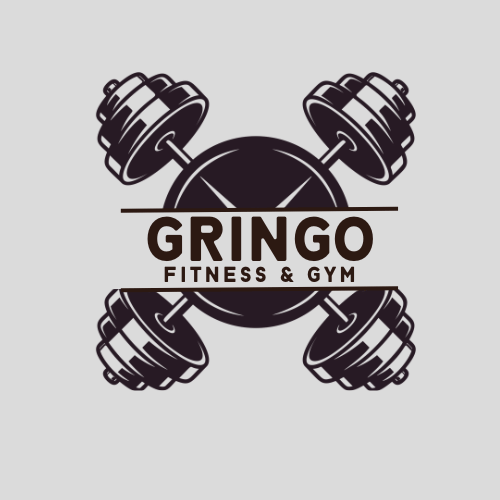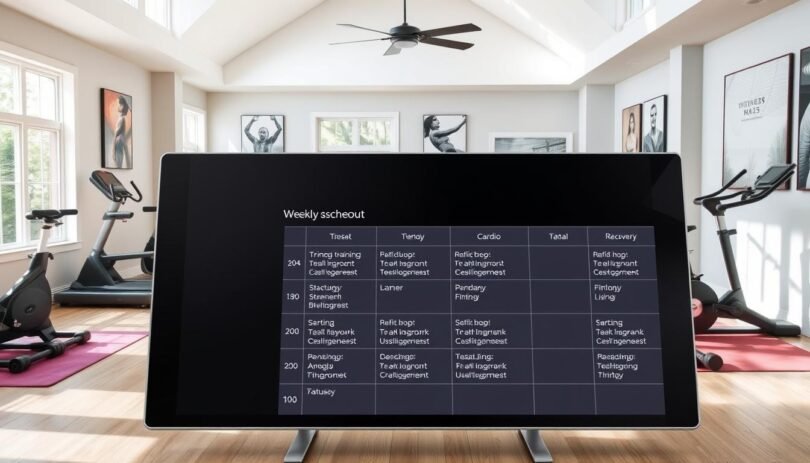Ever felt like your fitness efforts hit a wall? You’re not alone. Many people start strong but get lost in confusion. They wonder how much time to spend and which exercises to do.
The truth is, creating a good workout schedule isn’t a guess. It’s about following science and being consistent.
Imagine a plan that makes your goals real. The Mayo Clinic says starting a fitness program can lower disease risk and boost energy. But success isn’t just about showing up. This guide will help you create a routine that fits your life.
Science supports the steps in this guide. The American College of Sports Medicine says three 10-minute workouts daily are as good as one long session. For example, a 200-pound person aiming to lose 1–2 pounds weekly is a realistic goal. Muscle gains? Aim for 0.5–1 pound weekly. These numbers guide you.
Key Takeaways
- Follow a 5-step process to turn goals into actionable workout planning.
- Shorter exercise bouts (like 10 minutes, 3x daily) are as effective as 30-minute sessions (ACSM).
- Realistic progress matters: 0.5–1 lb muscle gain weekly for 200 lb individuals.
- Incorporate rest and recovery to avoid injury and maximize results.
- SMART goals and consistent tracking ensure progress stays on track.
Understand Your Fitness Goals
Creating a personalized fitness schedule begins with knowing what you want to achieve. Your goals guide everything, from the exercises you do to how much rest you need. Without clear goals, even the best customized workout plan can lose its way. Let’s explore how to set and prioritize your goals.
“Think about your fitness goals. Are you starting a fitness program to help lose weight? Or do you have another reason, such as training for a marathon?” – Mayo Clinic
Define Your Objectives
What change do you want to see? Goals can be to lose weight, gain muscle, improve endurance, or increase mobility. A marathon runner trains differently than someone doing yoga. List your top three goals and order them by importance.
Long-term vs. Short-term Goals
Combine big goals (like running a marathon) with smaller ones (like weekly 5K runs). This approach helps avoid burnout. For instance, aiming to lose 0.5% of body weight each week can help reach long-term weight loss goals.
Importance of Specificity
Goals like “get fit” are too vague. Use the SMART framework to make them clear: Specific, Measurable, Achievable, Relevant, Time-bound. Instead of “exercise more,” plan for “three 30-minute strength sessions weekly for six weeks.” Clear goals lead to action.
Assess Your Current Fitness Level
Knowing where you start is crucial for a fitness routine design that fits you. Without this, even the best structured workout routine might not work. The Mayo Clinic says, “Learn about your fitness level and write down your scores before you start your program.” This baseline helps you track your progress.
“Learn about your fitness level and write down your scores before you start your program. Use the scores as benchmarks against which to measure your progress.” – Mayo Clinic
Self-Evaluation Techniques
Start with simple tests you can do at home:
- Cardio Endurance: Time how long you can walk briskly or jog a mile.
- Muscular Strength: Count push-ups or squats to failure.
- Flexibility: Use a sit-and-reach test for hamstring flexibility.
- Body Composition: Measure waist circumference and track changes over time.
Using Fitness Assessments
Professional assessments give deeper insights. A VO2 max test shows how well your heart and lungs work. Body fat analysis shows muscle-to-fat ratios. Work with a trainer or gym to use these tools, making sure your fitness routine design meets your needs.
How to Track Progress
Keep track of your results in a journal or app like MyFitnessPal or Strava. Test yourself every six weeks to see how you’ve improved. Keeping track helps you stay on track and motivated.
| Assessment Type | Method | Measures |
|---|---|---|
| Push-Up Test | Max reps in 30 seconds | Muscular endurance |
| Waist Measurement | Tape measure at navel level | Core health |
| VO2 Max Test | Laboratory or app-based | Cardiovascular capacity |
Every number you log today is a milestone for tomorrow. This data helps you avoid guessing and keeps your structured workout routine on track. Start small, stay consistent, and let science guide your way.
Determine Your Available Time
Creating a weekly exercise program begins with knowing your time. It’s about matching your fitness goals with your daily life. Whether your schedule is packed or flexible, the goal is to find an optimal exercise schedule that works for you.
Weekly Time Commitment
First, figure out how many days you can dedicate to exercise each week. Studies say 2–4 sessions of 30–45 minutes can lead to progress. Even three 10-minute walks daily can add up, as the American College of Sports Medicine notes. Focus on being consistent rather than spending too much time.
- 2–3 days/week: Great for beginners who want to build strength and endurance.
- 4–5 days/week: Best for those with more time, balancing intensity and rest.
Daily Time Allocation
Short, intense workouts are very effective. HIIT or circuit training can give you results in 20–30 minutes. You can break your routine into smaller parts: a morning jog, a lunchtime workout, or an evening stretch. The ACSM says breaking up your workout is just as good as one long session.
“Consistency trumps frequency. Even 30 minutes twice a week can transform your health.” – NerdFitness
Importance of Consistency
Make exercise a priority by scheduling it like any other important appointment. Choose a time that works for you, whether it’s early morning, lunch, or evening. Link exercise to your daily habits, like walking after dinner. Remember, missing a workout doesn’t mean you’ve failed. Just adjust and keep going.
Choose the Right Types of Workouts
Creating a good workout schedule means picking exercises that match your goals. We’ll look at the three main areas of fitness: strength, cardio, and flexibility.
“There is no single type of exercise that can take care of all your needs. In fact, to get the most benefits from your routine, you want a mix of activities during the course of a week.”
Strength Training Options
Begin with basic exercises like squats, push-ups, and rows. Use tools like resistance bands, dumbbells, or just your body. Beginners should aim for 2–5 sets of 8–15 reps. The NSCA suggests increasing weight if you can do 2+ extra reps than planned. Make sure to do full-body workouts twice a week, focusing on legs, back, and core.
Cardiovascular Exercises
Combine steady-state activities (like walking or swimming) with high-intensity intervals (HIIT). The American College of Sports Medicine says even 10-minute sessions are beneficial. Aim for 150 minutes of moderate activity or 75 minutes of vigorous exercise each week. Pair this with strength training for a balanced routine.
Flexibility and Balance Workouts
Yoga or dynamic stretching boosts mobility. Hold stretches for 10–30 seconds, repeating 2–6 times. Older adults should add balance drills like heel-to-toe walking. Pair these with workout planning to prevent overtraining.
Workout planning is about finding the right balance. For muscle building, focus on lower-rep strength work. For weight loss, emphasize cardio. Always remember to be consistent and give your body time to recover—gradual progress is best.
Create a Balanced Workout Plan
A good structured workout routine mixes hard work, rest, and variety. It helps you make progress without getting too tired. Whether you’re just starting or have been working out for a while, your plan should match your goals and how well you recover. Here’s how to create a workout plan that fits your life and fitness level.
“The Physical Activity Guidelines for Americans recommend 150 minutes of moderate aerobic activity weekly, plus strength training twice a week with 48-hour recovery between sessions.”
Frequency and Duration Guidelines
Begin with the basics: aim for 150–300 minutes of moderate aerobic activity each week. Add two full-body strength sessions, with 48 hours off between them. For flexibility, do balance exercises 3 times a week if you’re prone to injuries. Shorter workouts (30–45 minutes) can be effective if you stick to them. Use this guide to build your structured workout routine:
- Moderate cardio: 30 minutes, 5 days/week
- Strength training: 2 sessions/week, 8–12 reps per set
- Recovery: 1–2 days of light activity or rest
Incorporate Recovery Days
Rest is not lazy; it’s crucial. Active recovery (like walking or yoga) helps your blood flow. Passive recovery (rest days) lets your body fix itself. Look out for signs of overtraining like feeling tired, irritable, or not performing well. Rest days should be paired with good sleep and nutrition for the best results.
How to Mix Different Workouts
Switch up your workouts to avoid getting stuck. Here’s a weekly example:
- Day 1: Upper body strength + 10-minute cardio warmup
- Day 2: 30-minute brisk walk
- Day 3: Lower body strength + core exercises
- Day 4: Active recovery (yoga/stretching)
- Day 5: High-intensity intervals (HIIT)
- Day 6: Full-body circuit training
- Day 7: Rest or light activity
Change your plan based on your goals. For endurance, focus on aerobic days. For strength, stagger muscle groups. Always do flexibility exercises after your workout to keep your body mobile.
Schedule Your Workouts
Your best workout schedule should match your energy highs and daily tasks. A good weekly workout plan needs to be consistent, flexible, and easy to follow. Let’s look at ways to make exercise a top priority without being too strict.
“Start slowly and build up gradually. Warm up with walking or stretching, then aim for 5–10 minutes of sustained effort.” – Mayo Clinic
Find out when you’re most awake. Morning workouts can kickstart your metabolism, while evening sessions might boost your performance. Try a week-long test to see when you have the most energy. It’s more important to be consistent than to pick the perfect time.
Tools for Tracking Success
Use digital tools like Google Calendar or MyFitnessPal to plan your workouts. Here’s how:
- Mark workout times like you would meetings
- Link workouts to daily routines (like walking after dinner)
- Set alerts for warm-ups and cool-downs
Adapt When Life Happens
Being too rigid can lead to failure. Add flexibility to your workout plan:
- Replace missed workouts with shorter ones (like 10-minute walks)
- Follow the NSCA’s 2-for-2 rule: Lift heavier if you can do more reps
- Have simple workouts ready for busy days (like 20-minute yoga)
| Day | Workout Type | Duration |
|---|---|---|
| Monday | Full-body strength training | 45 mins |
| Tuesday | Brisk walking + core work | 30 mins |
| Wednesday | Active recovery (yoga/stretching) | 20 mins |
| Thursday | Cycling or swimming | 40 mins |
| Friday | Lower-body resistance training | 35 mins |
| Saturday | HIIT or dance class | 25 mins |
| Sunday | Rest or light activity (e.g., walking) | Optional |
Good routines mix flexibility and structure. Tailor this plan to fit your goals. But always aim for at least 150 minutes of moderate exercise each week, as the American College of Sports Medicine recommends.
Set Realistic and Achievable Goals
A good fitness plan starts with goals that fit your abilities. SMART goals—Specific, Measurable, Achievable, Relevant, Time-bound—are your guide. Let’s explore each:
- Specific: Aim for “increase squat weight by 10 pounds in 6 weeks” instead of “get stronger.”
- Measurable: Use weekly weight logs or 5K run times to track your progress.
- Achievable
- Relevant: Choose goals that match your lifestyle—like endurance training for a marathon, not a sprint.
- Time-bound: Set deadlines like “lose 10 pounds by June 1st” to stay on track.
: Aim for a 0.5-1% weekly weight loss (e.g., 1-2 pounds for 200 lbs) to avoid extreme goals.
Celebrate your wins, like finishing a 30-day streak or crossing a 5K finish line. These achievements boost your motivation. Remember, progress isn’t always straight. Adjust your goals when life changes or you hit a plateau.
For example, if you’re not gaining muscle with a 250-calorie surplus, try the NSCA’s 2-for-2 rule. Increase weights if you can do two extra reps consistently.
Flexibility is crucial. A good fitness plan changes with you, ensuring your goals stay relevant. Enjoy the journey, not just the end.
Monitor and Evaluate Your Progress
Tracking your progress is key to your fitness journey. A structured workout routine needs regular checks to stay on track. Let’s look at how to measure results and adjust your plan for lasting success.
Tracking Your Workouts
Effective fitness routine design begins with logging workouts. Record important metrics like:
- Strength: Weight lifted, reps done, and rest times
- Cardio: Distance, time, and heart rate zones
- Flexibility: How far you can move
Apps like MyFitnessPal or Fitbit make tracking easy. Studies show users with trackers are 50% more successful than those without.
Adjusting Your Plan as Needed
Check your progress every 6–8 weeks. As Mayo Clinic suggests: “Reassess every six weeks. Adjust time or intensity if progress stalls.” If you feel tired or gains slow down, try these changes:
- Adding 10% more volume (e.g., 3 sets → 4 sets)
- Increasing resistance by 5%
- Switching exercise types (e.g., squats to lunges)
Importance of Feedback
Use both numbers (body measurements, performance stats) and feelings (sleep, mood). This mix helps avoid just focusing on the scale. Over 80% of exercisers find joy in non-scale victories like better sleep. If motivation wanes (a common issue at plateaus), review your structured workout routine to keep moving forward.
“Consistency in tracking creates clarity. Adjustments should reflect both measurable data and personal well-being,” says NASM-certified trainer Sarah Johnson.
Remember, progress isn’t always straight. Stay adaptable, celebrate wins, and let your routine grow with you.
Stay Motivated Throughout Your Journey
Staying committed to your weekly exercise program is not just about physical effort. It also needs mental strategies to keep going. Here’s how to keep the excitement alive and avoid getting tired of your optimal exercise schedule.
“If you lose motivation, set new goals or try a new activity. Exercise with a friend or take a class at a fitness center.” — Mayo Clinic
Motivation Techniques
Use both internal and external motivators:
- Track your progress with a fitness app or journal to see how far you’ve come.
- Give yourself mini-rewards for reaching milestones, like a massage or new workout gear.
- Make workouts more enjoyable by listening to music or taking scenic routes.
Find a Workout Buddy
Having someone to share the journey with can really help. Here’s how to find a workout buddy:
- Look for someone with similar fitness goals and schedules.
- Join group classes or online communities for extra motivation.
- Make sure you both know what to expect to avoid any surprises.
Keep Things Fresh and Fun
Change things up to avoid getting bored:
- Switch exercises every 4–6 weeks (like doing yoga one week and HIIT the next).
- Include “active recovery” days with activities like swimming or hiking.
- Slowly increase the weight or duration of your workouts, following NSCA guidelines.
Remember, it’s all about being consistent, not perfect. Celebrate your small victories and adjust your plan as your life changes. Your weekly exercise program should grow with you—stay curious and keep moving.
Overcoming Common Obstacles
Even the best workout plans can hit roadblocks. But, setbacks don’t have to stop your progress. Here are some ways to keep up with your fitness schedule, even when life gets busy.
“According to ACSM, the #1 reason people don’t exercise is: They don’t have time for it. All of us, all the time.”—NerdFitness
Time Management Strategies
Adapting to life’s demands is key for workout planning. Here are some tips to find time:
| Strategy | How to Apply |
|---|---|
| Micro-Workouts | Use 3×10-minute sessions (ACSM confirms this matches 1 long session) |
| Habit Stacking | Add squats during TV ads or walk during phone calls |
| Time Audit | Replace 30 minutes of scrolling with a brisk walk |
Dealing with Setbacks
Injuries or travel can throw off your plans. But, your fitness schedule should have a backup. Here’s what to do:
- Contingency workouts: Keep home exercises for gym closures
- Rehab routines: Use lighter resistance during recovery phases
- Reschedule, don’t abandon: Miss a day? Adjust your schedule flexibly
Maintaining a Positive Mindset
Starting with a positive mindset is crucial. Try this:
Change “I missed a day” to “I’ll adjust my personalized fitness schedule tomorrow”. Focus on non-scale wins like more energy. Celebrate small victories to keep motivated.
Incorporate Nutritional Considerations
Nutrition is key, not just an extra step. It’s the fuel for every workout. A customized workout plan works best with the right nutrition. Let’s see how matching meals and hydration with your creating an effective workout schedule can improve results.
Importance of Nutrition in Fitness
Macronutrients like protein, carbs, and fats are crucial for energy and recovery. For muscle gain, a 200-pound person needs a 250-calorie surplus each day. Losing weight means cutting 500 calories daily. Without the right fuel, even the best workouts can’t show results.
Protein is especially important after working out for muscle repair. Staying hydrated is also key: even a little dehydration can weaken strength by 10-20%.
Meal Planning Tips
- Time meals around workouts: Eat a mix of carbs and protein 1-3 hours before exercising. After, aim for 20-30g of protein within 45 minutes.
- Prep snacks: Keep protein bars or bananas on hand for quick energy on busy days.
- Track portions: Use a food scale or app to match calorie needs with goals. Small changes can make a big difference.
“Nutrition and exercise are two sides of the same coin. If you’re unsure, our coaches can design a meal plan that aligns perfectly with your goals.” – NerdFitness
Hydration and Its Role in Performance
Drink water before, during, and after workouts. Aim for 17-20 oz of water 2 hours before, then 7-10 oz every 10-20 minutes during long workouts. Electrolyte drinks are good for long activities. Check your urine color—it should be pale yellow, not dark.
Small changes can lead to big improvements. Matching your nutrition with your workout schedule helps your body adapt, recover, and grow. Adjust your portion sizes and hydration as your goals change. Your fitness journey is about nourishing every step, not just the reps.
Seek Professional Guidance When Needed
Getting help from experts can make your fitness plan better, especially for tough goals or health issues. Mayo Clinic says working with pros makes sure your program is safe and fits your needs. This could be for getting stronger or running longer.
Working with a Personal Trainer
A certified trainer will look at your goals and current fitness to create a plan just for you. They help set achievable goals, like gaining 0.5 pounds of muscle each week or losing 0.5-1% of your weight weekly. They also teach you how to do exercises right to avoid injuries and adjust the intensity as you get better.
Make sure the trainer is certified by organizations like NASM or ACE. It’s important they match your style and goals.
Benefits of Group Classes
Group classes can make you more accountable and motivated. They offer set workouts like HIIT, yoga, or cycling that fit into your busy schedule. The ACSM says even short, 10-minute workouts can be beneficial.
These classes also give you support from others. This support helps you stay on track, which is crucial for lasting success.
Online Coaching Options
Online coaching is great for those who can’t meet in person. Coaches use digital tools to track your progress, change your workout plan, and give nutrition tips. Apps like Fitbod or platforms like TrainHeroic offer customized programs.
Video sessions let coaches correct your form in real time. Make sure your coach has the right credentials and experience for your goals, like endurance training or recovery after injury.










